The Vegan Chinese Kitchen: 4 Recipes Even Carnivores Will Love

Plant-based Chinese cuisine, including this traditional dish of stuffed cabbage rolls, can be traced back over the centuries to Buddhist temple kitchens. Photo: Hannah Che
For many of us, classic Chinese fare involves tried-and-true meat-based favourites like kung pao chicken, Peking roasted duck, sweet and sour pork, sesame beef stir-fry … the list, of course, goes on and on.
But the cookbook The Vegan Chinese Kitchen by Hannah Che shows that nearly every dish in the Chinese repertoire can be replicated without animal protein, in a way that promises to satisfy vegans, vegetarians and carnivores alike.
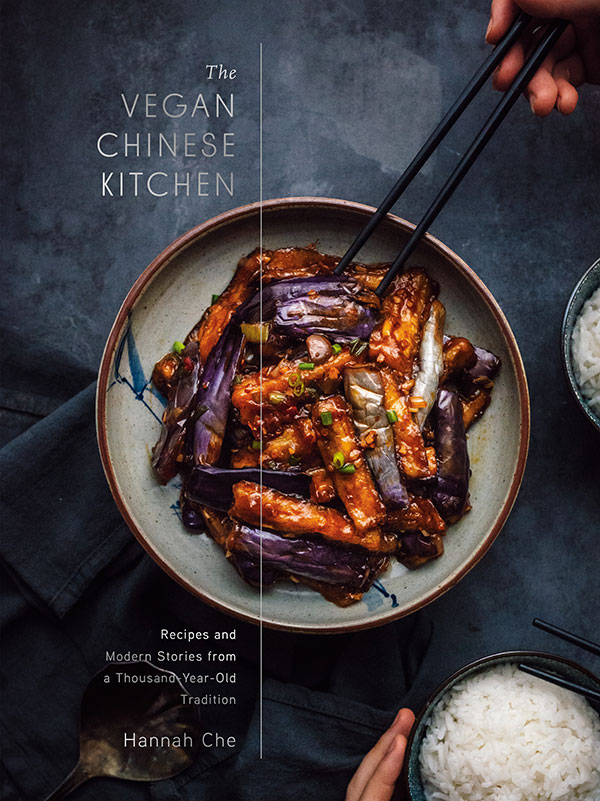
In fact, traditional plant-based Chinese cuisine, called zhai chi, can be traced back over the centuries to Buddhist temple kitchens. Che, who trained at China’s Guangzhou Vegetarian Culinary School, told Zoomer via email that the book was inspired by the vegetable-based meals she ate growing up in a Chinese family, “as well as my experience learning from Buddhist traditions in Guangzhou.’
The beautifully photographed book is jam-packed with recipes that are as delicious as they are nourishing. If you’d like to sample some of Che’s recipes, we serve up a few from the book, including the traditional temple dish of stuffed cabbage rolls, as well as kung pao mushrooms, braised tofu and stir-fried corn with pine nuts. But first we pass along some culinary tricks from chef Che.
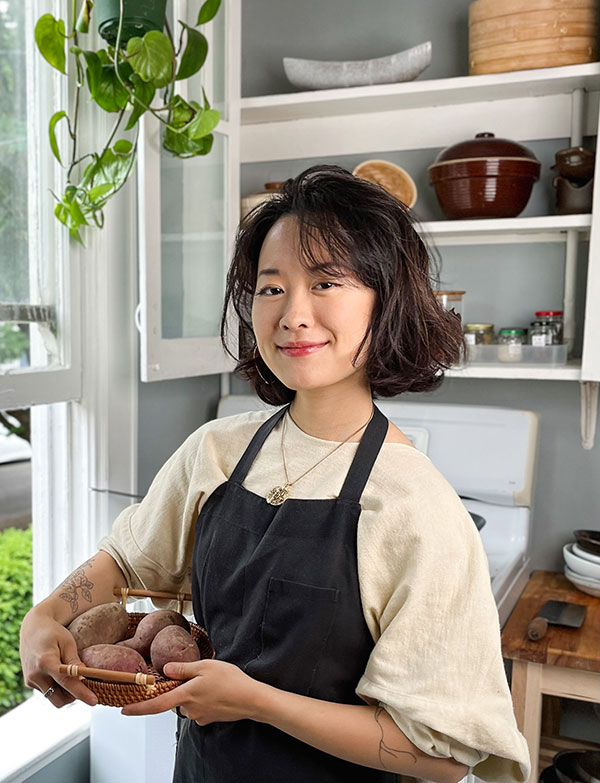
Insider Tips: Can you share your favourite flavour boosters — and any other secret weapons?
A good homemade chili oil will forever be my secret flavour weapon. It’s so easy to make yourself and endlessly versatile — you can drizzle it on noodles, fried rice, vegetable dishes, breads, soups, use it in dips and sauces, etc.
Easy Entertaining: What is your go-to dish for cooking/entertaining without the stress?
I always make a big pot of stew — recently I’ve been loving mapo tofu and Thai curry — and plenty of rice.
Must-Haves: What items/ingredients do you keep stocked in your pantry/fridge?
Tofu skin packs in my freezer — they thaw quickly and can be added to stir-fries and soups, or even steamed for a quick protein. For pantry essentials, definitely sesame oil, scallions, a good soy sauce and dried red chiles.
Finding Comfort: What is your go-to comfort food dish?
Any savory Chinese dish that involves potatoes or taro. I love my mom’s stewed green beans with potatoes, stir-fried slivered potatoes, cumin-roasted potatoes, clay pot taro, potatoes braised with eggplant …
Snack Attack: What is your favourite snack, healthy and otherwise?
Peanut butter-filled pretzel nuggets and frozen grapes, snacked on together.
RECIPES
Stuffed Cabbage Rolls
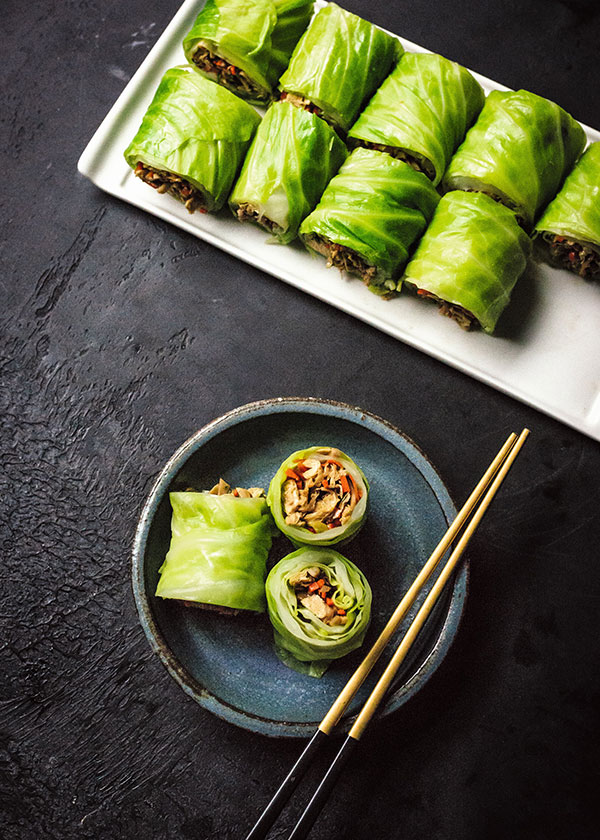
Serves 4 to 6
Ingredients:
Kosher salt
1 pound (450 grams) green cabbage, preferably flat-head cabbage, leaves separated (about 20 leaves)
2 tablespoons vegetable oil or scallion oil
1 tablespoon minced garlic
1 medium king oyster mushroom (6½ ounces/180 grams), both caps and stems thinly julienned
1 small carrot, thinly julienned
2 teaspoons soy sauce
4 ounces (112 grams) fresh or frozen and thawed tofu skin, cut into thin shreds
½ teaspoon ground cumin
½ teaspoon sugar
¼ teaspoon ground white pepper, or to taste
½ cup coarsely chopped fresh cilantro
¹⁄₃ cup crushed fried peanuts
1 teaspoon toasted sesame oil
Instructions:
1. Bring a large pot of generously salted water to a boil. Add the cabbage leaves and blanch until they are softened and vibrant green, about 1 minute. Refresh in cold water and drain in a colander.
2. Heat a wok over medium heat. Add the vegetable oil and swirl to coat the sides of the wok. Add the garlic and cook until aromatic, about 15 seconds. Add the mushrooms, carrot, and soy sauce. Stir-fry until the mushrooms have softened and released their liquid, about 3 minutes. Add the tofu skin, cumin, sugar, white pepper, and ½ teaspoon salt and stir until the tofu skin is heated through, scraping down any parts that stick to the wok. Remove from the heat and stir in the cilantro and crushed peanuts. Taste and add more salt, if needed. Transfer the filling to a bowl.
3. Lay one cabbage leaf on a cutting board and shave off its thick stem, trimming it as thin as possible without cutting into the leaf. The pared-down spine will make the leaf flatter and easier to bend. Repeat with the remaining leaves. Toss them in a large bowl with the sesame oil to lightly coat, giving the leaves a shine and aroma.
4. Lay out a bamboo sushi mat (or cover a tea towel with plastic wrap). Place a third of the leaves across the mat and flatten them. Place a third of the filling on the cabbage leaves, spreading it evenly and leaving an inch of the leaves exposed at the top and bottom. Hook your thumbs under the mat and lift the edge closest to you up and over the filling in the center. Press gently with curved hands along the length of the “log,” then pull the edge of the mat toward you and continue to roll the cabbage up and away from you. When you reach the far edge of the cabbage leaves, press the roll tightly once more, then remove the mat. Repeat with the remaining cabbage leaves and filling to make 2 more rolls. With a sharp serrated knife, slice the rolls into 2-inch-wide segments.
Enjoy immediately or chill before serving.
Kung Pao Mushrooms
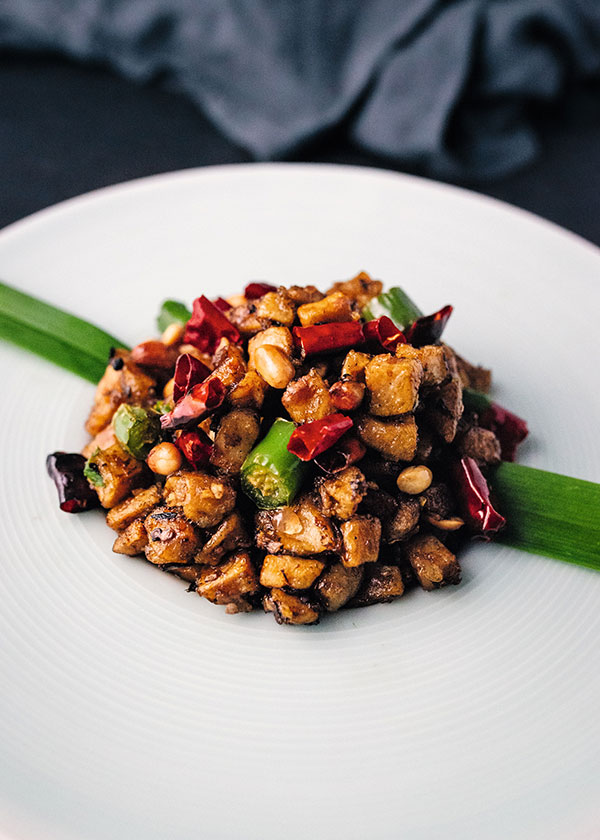
Serves 4
Ingredients:
The Sauce
2 teaspoons Chinkiang black vinegar
1 tablespoon Shaoxing wine
1 tablespoon soy sauce
2 teaspoons sugar
¼ teaspoon kosher salt
¼ teaspoon ground white pepper
¼ teaspoon potato starch
The Stir-Fry
2 medium king oyster mushrooms (10 ounces/280 grams), cut into ½-inch cubes (about 3 cups)
½ teaspoon soy sauce
½ teaspoon kosher salt
½ teaspoon toasted sesame oil
2 cups (480 ml) vegetable oil, for frying
¾ cup potato starch or cornstarch
1 (2-inch) piece (15 grams) fresh ginger, peeled and thinly sliced
2 garlic cloves, thinly sliced
¹⁄₃ cup dried red chiles (about 15), snipped into ½-inch segments and seeds shaken out
1 teaspoon whole Sichuan peppercorns
2 scallions, white parts only, cut into ¼-inch pieces
½ cup green chile pepper or bell pepper, cut into 1-inch pieces
½ cup dry-roasted peanuts or fried peanuts
Instructions:
The Sauce
Whisk together all the sauce ingredients in a small bowl until smooth and blended.
The Stir-Fry
1. In a large bowl, toss the mushroom cubes with the soy sauce, salt, and sesame oil, then let them rest for 5 minutes to release their liquid. Heat the vegetable oil in a wok over medium-high heat to 360 F (185 C), or until a wooden chopstick forms a merry stream of bubbles when inserted. While the oil is heating, check on the mushroom cubes—they should be damp. Add ½ cup of the starch to the bowl and squeeze the mushroom cubes to allow the starch to be absorbed. The mushroom cubes should still be slightly damp. Add the remaining starch and toss again, until each cube is coated with a generous amount. This will prevent them from sticking to each other when frying.
2. Fry the mushroom cubes in batches. Separate the cubes with your fingers as you drop them in to prevent them from clumping up. After about 15 seconds in the oil, the mushrooms will begin to sizzle and splatter as their internal water comes out. Stand back and wait until the splattering slows, then stir the cubes with a skimmer or spider until they are golden brown and crisp, about 2 minutes. Remove the cubes and transfer to a paper towel–lined dish. Bring the oil back up to temperature and repeat with the remaining mushrooms. Pour the oil into a heatproof container for another use, reserving 2 teaspoons in the wok.
3. Return the wok to medium heat. Stir-fry the ginger and garlic until fragrant, about 30 seconds. Add the dried chiles and peppercorns and stir-fry until the chiles start to darken, about 30 seconds. (Make sure your kitchen is well ventilated, as this will give off a stinging smoke.) Add the scallions, chile, and mushroom cubes, then increase the heat to high and pour the sauce down the side of the wok, so that it sizzles on the way to the bottom. Toss for 30 seconds, just until the sauce coats the mushroom cubes and everything is piping hot. Stir in the peanuts, remove from the heat, and serve
Homestyle Braised Tofu
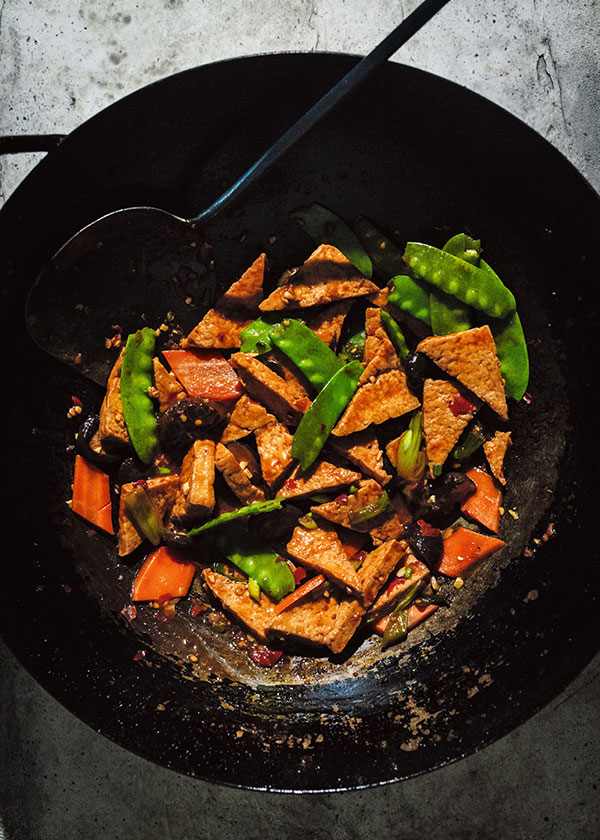
Serves 4 to 6
Ingredients:
3 large dried shiitake mushrooms, or ¼ ounce (7 grams) dried wood ear mushrooms
Boiling water
Kosher salt
14 to 16 ounces (390 to 450 grams) medium-firm tofu, cut into ½-inch-thick slices
½ teaspoon potato starch or cornstarch
Vegetable oil, for frying
1 tablespoon finely chopped garlic
1 tablespoon finely chopped fresh ginger
2 scallions, white parts cut into
1-inch segments, green parts thinly sliced and reserved for garnish
1½ tablespoons Sichuan chili bean paste
1 teaspoon soy sauce
1¼ cups (300 ml) unsalted stock of any kind or water
½ teaspoon sugar
½ cup thinly sliced (¼-inch) carrot (cut into semicircles or diamonds)
½ cup snow peas or green pepper, cut to match the carrot
Instructions:
1. In a small bowl, soak the shiitake mushrooms in boiling water for 30 minutes. Drain, snip off and discard the stems, and halve the caps. In a wok or saucepan, bring a few cups of generously salted water to a boil. Add the tofu slices and let soak for 3 to 5 minutes, then remove and blot dry with a clean tea towel.
2. Combine the starch with 1 tablespoon cold water in a small bowl. Heat ½ cup oil in a wok or skillet, or enough to cover the pan’s bottom by about ½ inch. When the oil is hot and shimmering, slide in as many tofu pieces as will fit in a single layer on the surface. Don’t move the tofu until a golden crust develops on one side, about 4 minutes. Flip and cook on the other side for about 3 minutes, transfer to a paper towel–lined plate, and repeat until all the tofu is golden brown, crispy, and slightly puffy. Transfer the frying oil to a heatproof container for another use, reserving 1 tablespoon in the wok.
3. Return the wok to medium-high heat. Stir-fry the shiitake mushrooms, garlic, ginger, and scallion whites until fragrant, about 2 minutes. Push the aromatics to one side of the wok, then add the chili bean paste and stir-fry briefly to release its flavor. Add the soy sauce, stock, and sugar. When the liquid is bubbling, add the fried tofu and carrot. Cover the wok and cook gently for 3 to 4 minutes to allow the tofu to absorb the flavors.
4. Uncover and add the snow peas. Return the heat to high and cook, stirring, until the liquid has reduced. Taste and adjust the flavors, adding more salt as needed. Give the starch slurry a stir and add it gradually to the wok, stirring continuously for 30 seconds, until the sauce is lightly thickened and clings to the tofu. Remove from the heat and stir in the scallion greens. Transfer to a dish and serve.
Stir-Fried Corn & Pine Nuts
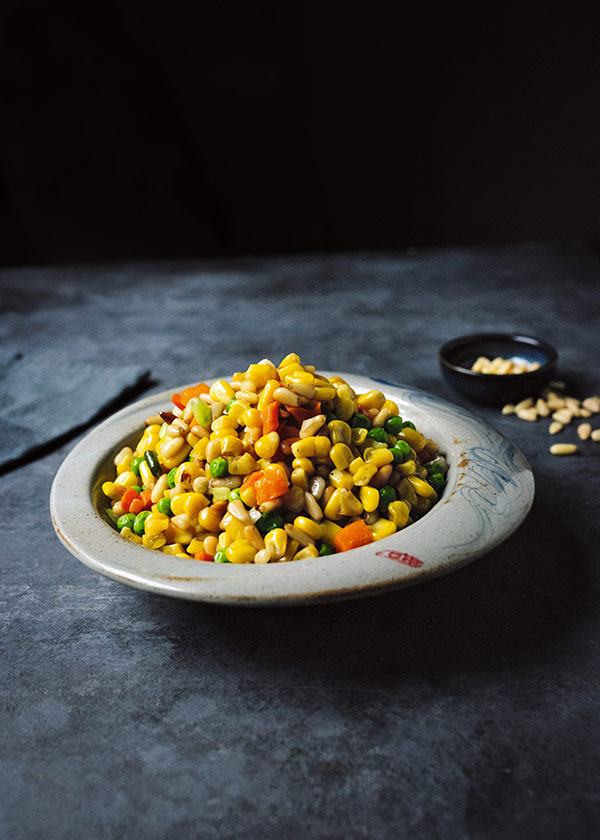
Serves 4
Ingredients:
½ teaspoon potato starch
Kosher salt
2 cups (10 ounces/280 grams) sweet corn kernels, frozen or cut off 2 fresh cobs
½ cup (2½ ounces/70 grams) shelled peas
¼ cup (2 ounces/50 grams) ¼-inch-diced carrot
3 tablespoons vegetable oil
²⁄₃ cup (2½ ounces/70 grams) pine nuts
1 scallion, white part only, cut into ¼-inch pieces
3 garlic cloves, minced
½ small red bell pepper (2 ounces/50 grams), seeded and cut into ¼-inch dice
1 tablespoon sugar
½ teaspoon toasted sesame oil
Instructions:
1. Make a slurry by combining the potato starch with 1 tablespoon cold water in a small bowl. Stir until smooth and set aside.
2. Bring a pot of salted water to a boil and blanch the corn kernels for 1 minute. When the water returns to a boil, add the peas and cook with the corn for 1 minute. Finally, add the carrot and blanch for 30 seconds. Remove everything with a slotted spoon and drain well in a colander. (If using frozen vegetables, skip this step and add them to the wok frozen to prevent them from becoming soggy.)
3. Heat a wok or skillet over low heat and add the vegetable oil, swirling to coat the sides. Add the pine nuts and stir-fry until they are light golden in color and smell wonderful, about 3 minutes. Remove the pine nuts with a slotted spoon and set them aside to drain on paper towels, leaving behind the fragrant oil.
4. Increase the heat to high. Add the scallions, garlic, and bell pepper and stir-fry until fragrant, about 30 seconds. Add the blanched corn, peas, and carrots to the wok and stir-fry briskly. Season with the sugar and 1 teaspoon salt. Add ¼ cup (60 mL) water and cook for about 2 minutes, until the vegetables have absorbed the flavors and the corn is juicy and tender. Give the starch slurry a stir and gradually add it to the wok, stirring continuously until the liquid has thickened and coats the vegetables with a thin, glossy sheen. Adjust the seasoning with salt and stir in the toasted pine nuts. Remove from the heat and drizzle with the sesame oil. Serve immediately.